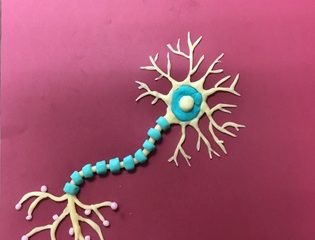I live in California, the Central Coast of California to be exact, and as far as the eye can see, we have vineyards. Needless to say, a major hobby in this part of the world is winetasting, made even more popular by the cult film Sideways. So when my childhood friends came to town to deliver their daughter to Cal Poly, we headed for Talley Vineyard to sample the local offerings.

The Intrepid Tasters at Work
As we sampled, talk turned to the differences between what experts can taste and what novices like ourselves (with the exception of Mr. F, who is a member of Knights of the Vines) can taste. Being me, I’m afraid that even in such recreational circumstances, I went into professor mode.
While I’m sure that you could train yourself to make small distinctions (dissociative learning as opposed to the associative type), a few things are working against the average taster. First of all, people differ vastly in the number of taste receptors they possess, and we can group them into nontasters, medium tasters, and supertasters. According to most of the tests, which you can take yourself by clicking the previous link, I am somewhere between a nontaster and a medium taster. So it’s pretty likely that I’m somewhat oblivious to bitter (also supported by my legendary coffee drinking), and pretty much all of the wines will taste good. Mr. F is a supertaster, and like most supertasters, he preferred a lighter Pinot, and opted out of the heavy red Cabernet at the end of the menu, which was my favorite.
Second, we have that nasty issue of expectation demonstrated so hilariously by Brian Wansink and his North Dakota wine. For those of you who are unfamiliar with the study, unsuspecting diners were served 2-buck-chuck with either a California wine label or a North Dakota wine label placed on the bottle by the experimenters. The people served “California” wine not only rated the wine as being better, but they rated the food served with the wine as better, ate 11% more of it (!!), and were more likely to make return reservations.
A more recent study looked at the influence of hearing an “expert’s” opinion before drinking it, and once again, we see that expectations matter. So a more reasonable line of research might be “why do we have critics in the first place?” I know chez Freberg that our movie interests are so different from most of the critics that we tend to avoid films with high ratings. Mr. F still hasn’t recovered from negative critical reviews at the debut of the original Star Wars. My guess is that people are influenced by conformity and other social factors to like what is generally considered good, or to show others that they have good taste.
Maybe the best approach is to ignore the critics, and have the confidence in your own judgment to just like what you like, even if it’s a North Dakota wine or Eddie Murphy’s Norbit. Check out this link for North Dakota pumpkin wine. Reminds me of “7 star patata” in Tea House of the August Moon. Oh, and the Talley wines were excellent (in my personal opinion, not to influence your expectations), and the service was, too.



1 Comment
Stephmena · November 16, 2009 at 4:50 pm
I don’t see why see why not a person could taste the differences between wines. There are people out there who hhave supersenses that influence there taste or sense of smell. And since smell and taste are interconnected it seems probable that people could tell the differences in wines. People can tell the difference between chile and rice why not wines. I also think that it is bassed on a persons preferences. For example, I hate wine but other people simply find it delicious.
Comments are closed.